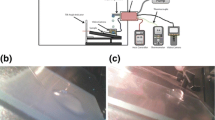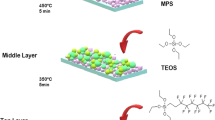Abstract
This study presents the formation of superhydrophobic films on glass surface resulted from hybrid assembly of inorganic–organic layers based on sol–gel-derived titania (TiO2)/dodecylamine (DDA). One-step and layer-by-layer (LbL) dip-coating approaches are compared and discussed as well as the effect of film annealing rates on the resulting hydrophobicity of glass surfaces. The hydrophobicity was obtained by measuring the water contact angle (WCA) of the films. It is shown that slow annealing rate combined with LbL sol–gel dip-coating produced robust coating with reasonable transparency. The effect of multiple coating and C to Ti mole ratios to the surface hydrophobicity of the resulted films is also reported. As a result, film transparency decreased with increasing coating times. Meanwhile, the C/Ti mole ratios predominantly affect WCA at higher coating numbers. Superhydrophobicity of WCA as high as 155.5° was observed for translucent hybrid film after three-time coating at C/Ti mole ratio of 7. The AFM image confirmed the surface roughness of 78 nm supported with homogeneous interconnected hybrid clusters of TiO2–DDA over the film surface as shown by the corresponding SEM images. Microhardness tester employing Vickers hardness number (VHN) was used to access the mechanical adhesion of the hybrid films by representing the film retention to scratching. It is observed that VHN increased as the C/Ti mole ratio increased with optimum condition achieving at C/Ti mole ratio of 5 (VHN of 60 kgf/mm2). All films have demonstrated good retention of hydrophobicity for 4 weeks outdoor at high-humidity (RH > 90 %) exposure. This work is expected to pave a way to the creation of transparent superhydrophobic films based on environmentally benign TiO2 inorganic–organic hybrid materials.














Similar content being viewed by others
References
Barthlott W, Neinhuis C (1997) Purity of the sacred lotus, or escape from contamination in biological surfaces. Planta 202:1–8
Batzill M, Morales EH, Diebold U (2006) Influence of nitrogen doping on the defect formation and surface properties of TiO2 rutile and anatase. Phys Rev Lett 96:26103–26122
Bravo J, Zhai L, Wu ZZ, Cohen RE, Rubner MF (2007) Transparent superhydrophobic films based on silica nanoparticles. Langmuir 23:7293–7298
Choi H, Antoniou MG, Pelaez M, De La Cruz AA, Shoemaker JA, Dionysiou DD (2007) Mesoporous nitrogen-doped TiO2 for the photocatalytic destruction of the cyanobacterial toxin microcystin-LR under visible light irradiation. Environ Sci Technol 41:7530–7535
Deng X, Mammen L, Zhao Y, Lellig P, Müllen K, Li C, Butt H-J, Vollmer D (2011) Transparent, thermally stable and mechanically robust superhydrophobic surfaces made from porous silica capsules. Adv Mater 23:2962–2965
Devi GS, Hyodo T, Shimizu Y, Egashira M (2002) Synthesis of mesoporous TiO2-based powders and their gas-sensing properties. Sens Actuators B 4351:1–8
Feng L, Li S, Li Y, Zhang L, Zhai J, Song Y, Liu B, Jiang L, Zhu D (2002) Superhydrophobic surfaces: from natural to artificial. Adv Mater 14(24):1857–1860
Furlong DN, Sing KSW, Parfitt GDJ (1979) Precipitation of silica on titanium dioxide surfaces. 1. Preparation of coated surfaces and examination by electrophoresis. J Colloid Interface Sci 69:409–419
Guo Z, Liu W, Su B (2011) Superhydrophobic surfaces: from natural to biomimetic to functional. J Colloid Interface Sci 353:335–355
Irie H, Watanabe Y, Hashimoto K (2003) Nitrogen-concentration dependence on photocatalytic activity of TiO2-xNx powders. J Phys Chem B 107(23):5483–5486
Kartini I (2004) Synthesis and characterisation of mesostructured titania for photoelectrochemical solar cells. PhD Thesis, University of Queensland
Kriesel JW, Sander MS, Tilley TD (2001) General route to homogeneous, mesoporous, multicomponent oxides based on the thermolytic transformation of molecular precursors in non-polar media. Adv Mater 13(5):331–335
Lai Y, Tang Y, Gong J, Gong D, Chi L, Lin C, Chen Z (2012) Transparent superhydrophobic/superhydrophilic TiO2-based coatings for self-cleaning and anti-fogging. J Mater Chem 22:7420–7426
Lee SG, Ham DS, Lee DY, Bong H, Cho K (2013) Transparent superhydrophobic/translucent superamphiphobic coatings based on silica–fluoropolymer hybrid nanoparticles. Langmuir 29:15051–15057
Levkin PA, Svec F, Fréchet JMJ (2009) Porous polymer coatings: a versatile approach to superhydrophobic surfaces. Adv Funct Mater 19:1–6
Lindgren T, Mwabora JM, Avendano E, Jonsson J, Hoel A, Granqvist C, Lindquist S (2003) Photoelectrochemical and optical properties of nitrogen doped titanium dioxide films prepared by reactive DC magnetron sputtering. J Phys Chem B 107(24):5709–5716
Mammeri F, Le Bourhis E, Rozes L, Sanchez C (2005) Mechanical characterization of hybrid materials. J Mater Chem 15:3787–3795
Mohammadi MR, Cordero-Cabrera MC, Fray DJ, Ghorbani M (2006) Preparation of high surface area titania (TiO2) films and powders using particulate sol–gel route aided by polymeric fugitive agents. Sens Actuators B 120:86–95
Nakajima A, Hashimoto K, Watanabe T (2001) Invited review: recent studies on super-hydrophobic films. Mon Chem 132:31–41
Nakata K, Sakai M, Ochiai T, Murakami T, Takagi K, Fujishima A (2011) Antireflection and self-cleaning properties of a moth-eye-like surface coated with TiO2 particles. Langmuir 27:3275–3278
Negishi N, Takeuchi K (2001) Preparation of TiO2 thin film photocatalysts by dip coating using a highly viscous solvent. J Sol Gel Sci Technol 22:23–31
Papoutsi D, Lianos P, Yianoulis P, Koutsoukos P (1994) Sol-gel derived TiO2 microemulsion gels and coatings. Langmuir 10:1684–1689
Prusty A, Gogoi N, Jassala M, Agrawala AK (2009) Synthesis and characterization of non-fluorinated copolymer emulsions for hydrophobic finishing of cotton textiles. Indian J Fiber Textile Res 35:264–271
Saha NC, Tompkins HG (1992) Titanium nitride oxidation chemistry: an X-ray photoelectron spectroscopy study. J Appl Phys 72:3072–3079
Stalder AF, Kulik G, Sage D, Barbieri L, Hoffman P (2006) A snake-based approach to accurate determination of both contact point and contact angles. Colloid Surf A Physicochem Eng Aspects 286:92–103
Tadanaga K, Kitamuro K, Matsuda A, Minami T (2003) Formation of superhydrophobic alumina coating films with high transparency on polymer substrates by sol–gel method. J Sol Gel Sci Technol 26:705–708
Vero N, Hribernik S, Andreozzi P, Sfiligoj-Smole M (2009) Homogeneous self-cleaning coatings on cellulose materials derived from TIP/TiO2 P25. Fibers Polymers 10(5):716–723. doi:10.1007/s12221-010-0716-2
Vinogradov VV, Agavonov AV, Vinogradov AV (2010) Superhydrophobic effect of hybrid organo–inorganic materials. J Sol-Gel Sci Technol 53:312–315
Williams DB, Carter CB (1996) Transmission electron microscopy: a textbook for materials science. Plenum Press, New York
Xiao SJ, Textor M, Spencer ND, Wieland M, Keller B, Sigrist H (1997) Immobilization of the cell-adhesive peptide Arg–Gly–Asp–Cys (RGDC) on titanium surfaces by covalent chemical attachment. J Mater Sci Mater Med 8:867–872
Xu QF, Wang JN, Smith IH, Sanderson KD (2009) Superhydrophobic and transparent coatings based on removable polymeric spheres. J Mater Chem 19:655–660
Yu J, Zhao X, Zhao Q (2000) Effect of film thickness on the grain size and photocatalytic activity of the sol-gel derived nanometer TiO2 thin films. J Mater Sci Lett 19:1015–1017
Zhang H, Lee Y, Leck KJ, Kim NY, Ying JY (2007) Recyclable hydrophilic–hydrophobic micropatterns on glass for microarray applications. Langmuir 23:4728–4731
Acknowledgments
The present study was supported by a Grant-in-Aid for International Research Collaboration and Scientific Publication from Indonesian Directorate General of Higher Education No. LPPM-UGM/1000/LIT/2014 and IPM UGM under contract no LPPM-UGM/2194/BID.I/2012. The authors also thank Dr. Risa Suryana (Physics Department, Universitas Negeri Surakarta) for his assistance with acquiring AFM images and Dr. Deendarlianto (Faculty of Engineering, Universitas Gadjah Mada) with water contact angle measurement.
Author information
Authors and Affiliations
Corresponding author
Electronic supplementary material
Below is the link to the electronic supplementary material.
Supplementary material 5 (MPG 46102 kb)
Supplementary material 6 (MPG 31522 kb)
Supplementary material 7 (MPG 21646 kb)
Rights and permissions
About this article
Cite this article
Kartini, I., Santosa, S.J., Febriyanti, E. et al. Hybrid assembly of nanosol titania and dodecylamine for superhydrophobic self-cleaning glass. J Nanopart Res 16, 2514 (2014). https://doi.org/10.1007/s11051-014-2514-z
Received:
Accepted:
Published:
DOI: https://doi.org/10.1007/s11051-014-2514-z




